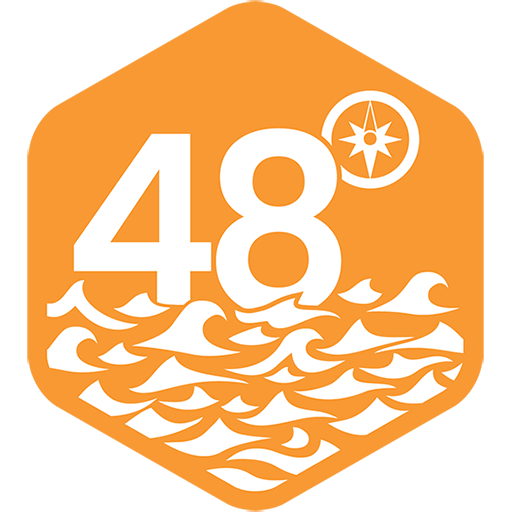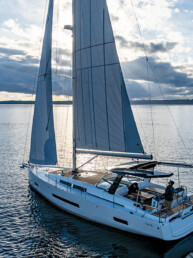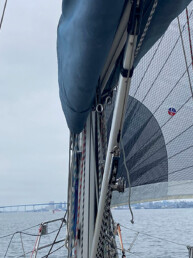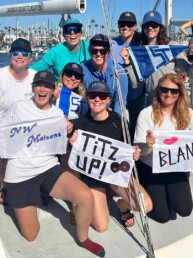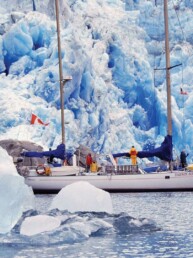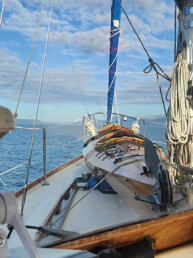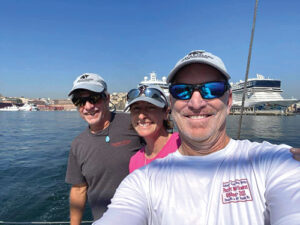 Last month, we started at the end (of the year, not the project), recapping our Jeanneau SunFast 3300 (SF3300) Red Ruby’s last race in 2022, the Rolex Middle Sea Race. This month we are going to step a little bit farther back to the fall of 2021 and the genesis of the Red Ruby Project.
Last month, we started at the end (of the year, not the project), recapping our Jeanneau SunFast 3300 (SF3300) Red Ruby’s last race in 2022, the Rolex Middle Sea Race. This month we are going to step a little bit farther back to the fall of 2021 and the genesis of the Red Ruby Project.
After returning from Italy in September — where my wife and sailing partner, Chris, and I had just competed in the Mixed Doubles Offshore World Championships in Figaro 3s — we had the good fortune to spend an evening with Ron Rosenberg and Jonathan McKee. We spent several hours reviewing the event and then talking about what might be next for us. We wanted to do more doublehanded distance races, and were excited about many of the classic distance races around the world (Fastnet, Middle Sea Race, Caribbean 600, Sydney Hobart, among others). That meant primarily racing outside of the U.S. To do that, we needed a boat. Chartering didn’t have appeal, as we were concerned about being able to prepare the boat to the level we envisioned. Buying a boat didn’t seem practical since we would, at most, be able to use the boat three to five times per year. Partnering on a boat though? That seemed promising, and so we set the idea on simmer.
A few months later, Chris and I learned of the UK Doublehanded Offshore Series (UKDHOS). For 2022, that would be a six-race series with the top four races used for a boat’s end of season score. The races were all distance races (mostly overnight) ranging in distance from 75 to 230 nautical miles. Several things about the series appealed to us. In 2021, each race was getting 30+ doublehanded entries, and all of the boats were similar in size and rating. Also, there were a lot of SF3300s in the fleet, which we were interested in.
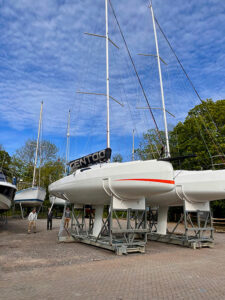
We shared what we had learned with Ron and Jonathan, highlighting the fact that racing a SF3300 in the UK would be a way to get up to speed quickly, since we would have instant feedback on performance with so many sisterships on the race course. That seemed particularly important given the limited time we could realistically commit to sailing a boat in Europe. The UK was becoming a magnet for SF3300s, growing a fleet of more than 20.
Many 48° North readers probably know this already, but Jonathan has a lot of shorthanded sailing experience (Mini Transat and Barcelona World Race for starters), and he is keen on continuing to do more shorthanded, particularly doublehanded, races in interesting places. Tah dah! A solution to the boat problem — a 50/50 partnership with Jonathan. We spent the 2021 holiday season looking for the right boat, which we quickly narrowed down to a used (2020) SunFast 3300 located in Hamble, UK, which is, not coincidentally, ground zero for the UKDHOS.
By the end of January 2022 we had a competitive boat, renamed Red Ruby, sitting on the hard, waiting for our next move. We also had a very appealing team to campaign Red Ruby. Jonathan would be partnering with Alyosha Strum-Palerm, one of Seattle’s brightest young sailors who has sailed a lot with Jonathan, including notching an R2AK win together in 2022, followed by a great performance in the Pacific Cup together on the Riptide 41, Blue. Chris and I would compete together, having raced doublehanded together for more than 25 years. Effectively, we were setting up two campaigns using the same boat.
From the outset, we have been able to capitalize on the skillset and enthusiasm that the team brings to the table, and we are building on our individual and shared experiences with race debriefs and analysis. As an example, all of us bring an analytical approach to making a boat go fast. This is aided by Jonathan’s amazing ability to evaluate rig tune and sail shape, and the rest of us are super eager to absorb that knowledge. We all enjoy digging into the details and believe in rigorous preparation, which, no surprise, is a big benefit when you are trying to campaign a boat remotely.
Chris is the supreme campaign director, making sure that we arrive at a race with no loose ends, ready to focus on the boat and the race. Alyosha, in addition to his youthful energy, brings an eye for the details of boat preparation and sail handling, honed from his time as a successful high school sailing coach, and the decision to enthusiastically dive into keelboat racing as a young teenager. I went to grad school in meteorology, so we all feel pretty good about our pre-race planning, routing, and strategy. Jonathan says, “It feels more like a 4-person team than two 2-person teams, and I think that is pretty unique in the sailing world.”
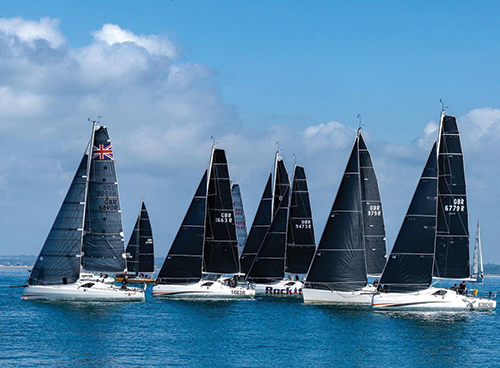
It is that team dynamic that has made year one of the Red Ruby project a success.
But why name the boat Red Ruby? Red Ruby is named after the Pacific Northwest’s smallest octopus, the Red Ruby Octopus (Octopus rubescens). These animals are quite intelligent, can change the color of their skin to camouflage themselves, and make their home in rocky intertidal areas. We wanted to name the boat after an inspiring marine animal living in the Salish Sea — a tribute to our Pacific Northwest origins while competing in far flung parts of the world.
Stay tuned for more stories from Red Ruby. Next month, we’ll discuss the details of getting Red Ruby ready for the 2022 UKDHOS and beyond.
